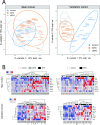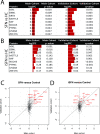Novel Autoantibodies in Idiopathic Small Fiber Neuropathy
- PMID: 34761434
- PMCID: PMC9300200
- DOI: 10.1002/ana.26268
Novel Autoantibodies in Idiopathic Small Fiber Neuropathy
Abstract
Objective: Small fiber neuropathy (SFN) is clinically and etiologically heterogeneous. Although autoimmunity has been postulated to be pathophysiologically important in SFN, few autoantibodies have been described. We aimed to identify autoantibodies associated with idiopathic SFN (iSFN) by a novel high-throughput protein microarray platform that captures autoantibodies expressed in the native conformational state.
Methods: Sera from 58 SFN patients and 20 age- and gender-matched healthy controls (HCs) were screened against >1,600 immune-related antigens. Fluorescent unit readout and postassay imaging were performed, followed by composite data normalization and protein fold change (pFC) analysis. Analysis of an independent validation cohort of 33 SFN patients against the same 20 HCs was conducted to identify reproducible proteins in both cohorts.
Results: Nine autoantibodies were screened with statistical significance and pFC criteria in both cohorts, with at least 50% change in serum levels. Three proteins showed consistently high fold changes in main and validation cohorts: MX1 (FC = 2.99 and 3.07, respectively, p = 0.003, q = 0.076), DBNL (FC = 2.11 and 2.16, respectively, p = 0.009, q < 0.003), and KRT8 (FC = 1.65 and 1.70, respectively, p = 0.043, q < 0.003). Further subgroup analysis into iSFN and SFN by secondary causes (secondary SFN) in the main cohort showed that MX1 is higher in iSFN compared to secondary SFN (FC = 1.61 vs 0.106, p = 0.009).
Interpretation: Novel autoantibodies MX1, DBNL, and KRT8 are found in iSFN. MX1 may allow diagnostic subtyping of iSFN patients. ANN NEUROL 2022;91:66-77.
© 2021 The Authors. Annals of Neurology published by Wiley Periodicals LLC on behalf of American Neurological Association.
Conflict of interest statement
Nothing to report.
Figures




References
-
- Basantsova NY, Starshinova AA, Dori A, et al. Small‐fiber neuropathy definition, diagnosis, and treatment. Neurol Sci 2019;40:1343–1350. - PubMed
-
- Sala TP, Villedieu M, Damian L, et al. Long‐term efficacy of immunoglobulins in small fiber neuropathy related to Sjögren's syndrome. J Neurol 2020;267:3499–3507. - PubMed
Publication types
MeSH terms
Substances
LinkOut - more resources
Full Text Sources
Research Materials
Miscellaneous

